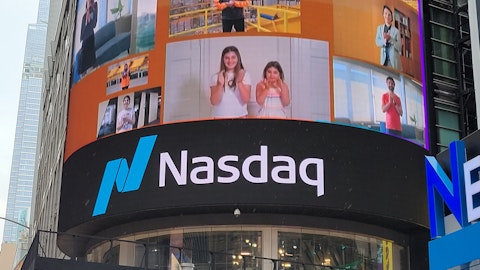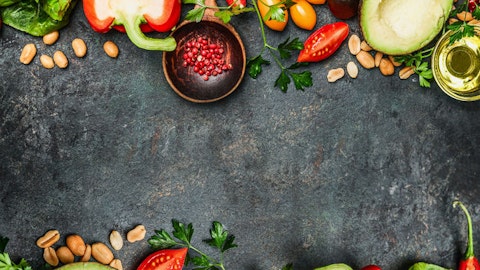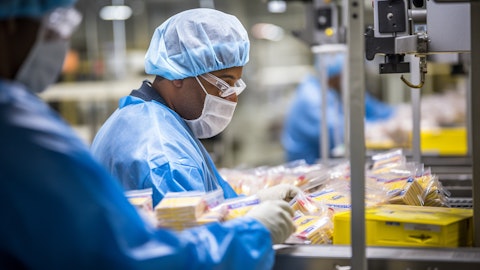Conagra Brands, Inc. (NYSE:CAG) Q2 2024 Earnings Call Transcript January 4, 2024
Conagra Brands, Inc. beats earnings expectations. Reported EPS is $0.71, expectations were $0.68. CAG isn’t one of the 30 most popular stocks among hedge funds at the end of the third quarter (see the details here).
Operator: Good morning, and welcome to the Conagra Brands Second Quarter Fiscal 2024 Earnings Call. [Operator Instructions] Please note, this event is being recorded. I would now like to turn the conference over to Bayle Ellis, Manager of Investor Relations. Please go ahead.
Bayle Ellis: Good morning, and thanks for joining us for the Conagra Brands second quarter and first-half fiscal 2024 earnings call. Sean Connolly, our CEO; and Dave Marberger, our CFO, will first discuss our business performance, and then, we’ll open up the call for Q&A. We will be making some forward-looking statements today. And while we are making those statements in good faith, we do not have any guarantee about the results we will achieve. Descriptions of our risk factors are included in the documents we filed with the SEC. We will also be discussing some non-GAAP financial measures, including adjusted numbers that exclude items, management believes, impact the comparability for the period referenced. Please see the earnings release and the slides for GAAP to non-GAAP reconciliations, and information on our comparability items, which can be found in the Investor Relations section of our website. I’ll now turn the call over to Sean.
Sean Connolly: Thanks, Bayle. Good morning, everyone, and Happy New Year. Thank you for joining our second quarter fiscal ’24 earnings call. Let’s start with the Q2 headlines, shown here on Slide 5. At a macro level, the industry-wide shifts in U.S. consumer behavior, that we discussed on last quarter’s call, persisted into the second quarter. These behavior shifts continued to pressure volume and mix. However, while the consumer is still deploying some value-seeking tactics when they shop, we are seeing clear progress when it comes to volume recovery. In Q2, that progress was most notable in our Refrigerated and Frozen segment, in particular, our Frozen business. This inflection was helped by investments on key brands as we were seeking to understand consumer readiness to revert back to more typical purchase behaviors.
We saw outstanding responsiveness that will inform our back-half actions. More on that in a moment. The net result was a clear improvement in volume trends, with domestic retail volume loss that was half of what we saw in Q1. We delivered solid margins and EPS, as well as excellent free cash flow conversion. Our productivity initiatives remain on track. Although, we also saw some absorption impact from our volume declines. As we look ahead to the second-half, we have a robust investment plan in-place, reflecting our increased confidence in consumer responsiveness to brand building levers. Our goal is to continue to build momentum with our consumers as we move through the back-half of the fiscal year, and then, enter fiscal ’25 in a position of strength.
I will share more on our multifaceted action plan in a few minutes. Finally, we are updating our guidance for fiscal ’24, reflecting both the consumer environment and the additional brand investments in the second-half of the year. After tremendous initial resilience in the face of a record inflation super cycle, U.S. consumer behavior shifts did emerge last spring in our industry as the cumulative effect of inflation caused consumers to begin to stretch their budgets. This resulted in a reprioritization of food choices as shoppers adjusted purchase behavior towards more stretchable meals. This slide reprises some of those shifts we discussed last quarter. At that time, we told you that we expected these trends to be transitory. We still believe that to be the case.
But the pace of the shift back to normal consumer behavior has been slower than we initially expected, and that pressured our volume, performance and mix in the second quarter. That said, the tide appears to be turning. When we discussed these behavior shifts last quarter, Frozen was one of our most impacted businesses, specifically, our frozen single-serve meals. After five years of consistent strength, we saw some consumers looking to alternatives such as multi-serve meals and scratch cooking to stretch their budgets. We didn’t expect that trend to be lasting as the unshakable consumer demand for convenience, combined with Conagra driven product innovation, has generated strong Frozen demand for a long-time now. As I noted in my opening remarks, we believe it’s important to understand consumer readiness to resume more typical shopping behaviors before more fully ramping-up investments to facilitate the process.
We want to be confident that our investments will have the desired impact. With that in mind, during the second quarter, we did invest in certain key businesses to assess consumer response to increased brand building stimulus. Most noteworthy was our largest Frozen business, single-serve meals, where we deployed high-quality merchandising nationally. The results were very encouraging, with lifts up 60%. These lifts ultimately drove meaningful gains in our market share. As you can see on this slide, our Q2 share in this business approached 51%, eclipsing last year’s gains and also setting a new record. The net of this is while the consumer is still stretched, they are responding to high-quality brand building stimulus. And when you look at volume trends, while not yet positive, you can see that progress is clearly underway.
Slide 9 shows volume results in our key U.S. retail segments, both separately and combined. I’ll draw your attention to the chart on the left, where you can really see the impact of our investment actions. As a result of these investments, Refrigerated and Frozen segment volume went from minus 10.5% in the first quarter to minus 3.3% in the second quarter, coming in-line with volumes in Grocery and Snacks. Overall, our targeted investments in Q2 helped cut the total domestic retail volume decline in half compared to the first quarter, not all the way back, but good progress. I’m also pleased to report that we continued to deliver momentum in our International and Foodservice businesses, which together account for approximately 18% of total Q2 revenue.
International grew organic net sales by 5.6% in the quarter, while our two largest markets, Mexico and Canada, delivered organic net sales growth above 9%. This was a result of our International team’s outstanding execution, including strong brand activation, improved point-of-sale performance, innovation that is resonating with our customers, and expanded distribution in Mexico. Our Mexican business has now delivered four consecutive quarters of volume growth. In Foodservice, we delivered organic net sales growth of 4.3% in the quarter, driven largely by favorable price mix as well as expanded distribution in our Frozen portfolio, which accounted for roughly half of our total Foodservice business. Slide 11 details our second quarter results, including organic net sales of approximately $3 billion, which is down 3.4% compared to last year.
Adjusted gross margin of 26.9% was down 129 basis points from last year, reflecting our targeted investments and the absorption impact associated with the volume decline. Adjusted operating margin of 15.9% was down 108 basis points compared to last year and adjusted earnings per share of $0.71 was down approximately 12% versus last year. Importantly, we delivered strong free cash flow during the second quarter. Dave will cover this in more detail shortly. But as you can see on Slide 12, free cash flow in the first-half of fiscal ’24 was almost six times what it was in the first-half of fiscal ’23. We used some of that free cash flow to paydown debt, bringing our net leverage ratio to 3.55 times in the second quarter. As I mentioned earlier, we have a robust and multifaceted investment plan in-place for the second-half of the year, reflecting our confidence in consumer responsiveness to our brand building efforts.
On Slide 13, you can see images from our new advertising investments, focused on our biggest brands, including Birds Eye, Healthy Choice and Slim Jim. You may have already seen some of the terrific work we’ve done this year with Slim Jim and the WWE, building on the heritage and built-in awareness of our long-term partnership with Wrestling Legend, Randy Macho Man Savage. Fiscal ’24 is one of our biggest innovation slates yet. We are backing those launches with meaningful increases in slotting in-store and other sales support versus the prior year. Slide 14 highlights some of the exciting innovation we’ve recently launched. If we have any chili lovers on the call, I highly recommend our Wendy’s Chili. You can get the true restaurant taste of this beloved Chili at home.

Finally, Slide 15 highlights the investments we’re making in high-quality merchandising. Our efforts are focused on reengaging consumers with our existing products to capture market share as well as introducing consumers to our new innovation. The targeted investments we made during the second quarter give us confidence that our multifaceted brand building investments in the second-half of the year will drive momentum going into 2025. We’re updating our guidance for fiscal ’24, reflecting both the consumer environment and the additional brand investments in the second-half of the year, our new guidance includes organic net sales decrease between 1% and 2% compared to fiscal ’23, adjusted operating margin of approximately 15.6%, and adjusted EPS between $2.60 and $2.65.
Overall, we remain confident in our brands, plans, people and agility, as we continue to navigate this shifting consumer environment. With that, I’ll pass the call over to Dave to cover the financials in more detail.
Dave Marberger: Thanks, Sean, and good morning, everyone. Slide 18 highlights our results from the quarter. Overall, our team executed well as we continue to navigate consumer behavior shifts that pressured our volume and mix. In Q2, net sales were $3.2 billion. As Sean discussed earlier, this reflects a 3.4% decrease in organic net sales, driven primarily from lower year-over-year volumes. However, this is the third quarter in a row, where the rate of volume change versus the prior year quarter improved. Amid these broader macroeconomic challenges and increased brand investments, we delivered solid margins and EPS, along with strong free cash flow during the second quarter. Adjusted gross profit decreased by 7.6% in the quarter as the positive impact from productivity initiatives was offset by cost of goods sold inflation, unfavorable operating leverage, lower organic net sales and increased trade investment.
Adjusted operating profit decreased 9.3% and adjusted EBITDA decreased 7%, largely driven by the decrease in adjusted gross profit, partially offset by an increase in equity earnings, driven by continued strong operating performance in our Ardent Mills joint venture. We delivered Q2 adjusted net income of $341 million or $0.71 per diluted share. Slide 19 provides a breakdown of our net sales for Q2. The 3.4% decrease in organic net sales was primarily driven by the consumer dynamics just discussed. Further contributing to the decline was a 0.5% decline in price mix, which reflects an increase in strategic trade investments made during the period and an unfavorable mix impact from selling a higher percentage of lower sales dollar per unit items.
This was partially offset by price increases taken on our tomato-based products, given the continued high inflation. We also saw a small benefit from foreign exchange, which is reflected in our net sales decline of 3.2%. Slide 20 outlines the top-line performance for each segment in Q2. While organic net sales were down in our domestic retail segments, we delivered sequential volume progress that benefited from the targeted strategic investments Sean discussed earlier. We also continued the strong momentum in our International and Foodservice segments, which delivered Q2 organic growth of 5.6% and 4.3%, respectively. Slide 21 shows our Q2 adjusted margin bridge. While our productivity initiatives remain on track, our margin was negatively affected by the continued impact of overhead absorption from our lower volumes.
Cost of goods sold inflation was a headwind of 1.7% and price mix was a 0.6% headwind, which reflects the retailer investments made during the period. These factors, combined, drove the decline in adjusted gross margin for the quarter. Our adjusted operating margin benefited from small year-over-year favorability in A&P and SG&A. Slide 22 details our margin performance by segment for Q2. Adjusted operating margin in both our Grocery and Snacks and Refrigerated and Frozen segments decreased due to the margin drivers I just discussed, although inflation impacted the Grocery and Snacks segment at a higher-rate than Refrigerated and Frozen. We were pleased that our Foodservice adjusted operating margin expanded 193 basis points and our International segment’s adjusted operating margin expanded 30 basis points, both driven by higher organic net sales and productivity, as both segments are showing consistent improvement.
Foodservice also benefited from comparison to prior year Q2, which included supply chain disruptions. Our Q2 adjusted EPS performance of $0.71 was $0.10 below the prior year quarter, primarily from the decline in adjusted gross profit and pension income and higher interest expense. This was partially offset by slightly lower A&P and adjusted SG&A expense, along with increased equity method investment earnings driven by Ardent Mills. The A&P change was timing-related, as we expect to increase A&P spending in the second-half, and the decline in SG&A was primarily the reduction in incentive compensation versus the prior year. Slide 24 displays the significant progress we made in the quarter and first-half on free cash flow and our net leverage ratio.
Over the first-half of fiscal ’24, we delivered a $532 million improvement in free cash flow with a conversion rate of approximately 97%, the highest first-half conversion rate over the past five years. Our focus on managing inventory levels and improvement in accounts payable directly contributed to these strong results. In addition, we had strong cash distributions from Ardent Mills in the second quarter, reflecting the strong profit and cash flow performance of Ardent Mills the last few years. Our strong free cash flow has helped us deliver debt reduction during the period. At the end of Q2, our net leverage ratio was 3.55 times, reflecting debt repayment of more than $500 million over the last 12 months. Looking ahead to the remainder of fiscal ’24, we expect to continue our debt reduction efforts as we prioritize our long-term leverage target of 3 times.
We chose not to repurchase any shares in the quarter as we continue to prioritize paying down debt this fiscal year. We will continue to evaluate the best use of capital to optimize shareholder value as we progress through the fiscal year. As mentioned, we are updating our guidance for fiscal ’24 to reflect our year-to-date results, expectations for the slower pace of volume recovery and the additional brand investments in the second-half. Slide 25 outlines our expectations for our three key metrics, including organic net sales to decrease between 1% and 2% compared to fiscal ’23, with volumes continuing to improve through the back-half of the year. Adjusted operating margin of approximately 15.6% and adjusted EPS between $2.60 and $2.65. Turning to Slide 26.
I’d like to take a minute to walk-through the considerations and assumptions behind our guidance. We expect net inflation to moderate through the remainder of the fiscal year, resulting in an inflation rate of approximately 3% for fiscal ’24. Regarding pricing, there are a few dynamics currently at play. With our estimated 3% inflation rate, we are seeing areas that are still highly inflationary such as tomatoes and starches, which are up above the average, and areas that are deflationary such as edible oils and dairy, which are below the average. These dynamics have resulted in both inflation justified pricing actions and select pass-through price reductions included in our outlook. We expected – expect that these dynamics, combined with our increased second-half investments, will result in price mix being down versus prior year in the second-half.
We now anticipate CapEx spend of approximately $450 million in fiscal ’24, as we continue to make investments to support our growth and productivity priorities with a focus on capacity expansion and automation. As a result, we continue to expect to achieve gross productivity savings of approximately $300 million by the end of fiscal ’24. We expect interest expense to approximate $440 million, primarily due to a higher weighted average interest rate on outstanding debt. While we do not expect to receive any benefit from pension income, we expect Ardent Mills to contribute approximately $170 million to our bottom-line due to its continued strong performance. Our full-year tax-rate estimate remains approximately 24%. As I discussed, we are prioritizing our debt reduction efforts and expect to further reduce our outstanding net debt in the second-half.
Longer-term, we remain on track to reach our 3 times net leverage ratio target by the end of fiscal ’26. That concludes our prepared remarks for today’s call. Thank you for listening. I’ll now pass it back to the operator to open the line for questions.
See also 30 Places Where People Live The Longest in The World and Best Car Accident and Personal Injury Lawyers in Each of 30 Biggest Cities in the US.
Q&A Session
Follow Conagra Brands Inc. (NYSE:CAG)
Follow Conagra Brands Inc. (NYSE:CAG)
Operator: We will now begin the question-and-answer session. [Operator Instructions] And our first question will come from Andrew Lazar of Barclays. Please go ahead.
Andrew Lazar: Hi, good morning, everybody.
Sean Connolly: Morning, Andrew.
Dave Marberger: Morning.
Andrew Lazar: Hi, Sean, I know that – I think, investor concern for the Group as a whole, right, has been sort of building that there would ultimately be a need for sort of greater price investment to deliver volume improvement, and that it could get to the point where it could start more negatively impact sort of margin profiles. So, I guess, my question is, how can we be comfortable that the investments being made are sort of ROI or value-enhancing rather than, let’s say, money being spent to simply flatter volume at the expense of margins and sort of disrupt the broader competitive environment?
Sean Connolly: Well, I think, Andrew, in terms of how we think about return on investment, let me be very clear around what we are and what we’re not doing in support of our brands. Number one, as you heard in our prepared remarks, we’ve got a multifaceted investment plan that spans advertising, innovation support, merchandising support and more. Number two, we’ve got an ROI mindset in everything we do. This Company has worked very hard to expand our operating margins over the last nine years and we did not get there by being frivolous. Number three, with respect to merchandising, I’ve consistently pointed out that there was room to do more in a high-quality way, operative words high-quality, now that the supply chain is humming again, especially on key brands and around key merchandising windows.
And as you know, Conagra’s merchandising today is very different from a decade ago. Our overall merchandising levels are below peers and our depth of discount is extremely reasonable. It’s been, over the last several years, more of a frequency strategy. The last point I’ll make is that part of our ROI mindset is understanding where the consumer is in terms of their readiness to reengage with more typical purchase behaviors and it was important that we test that a bit in Q2. And as you heard in our remarks, we liked what we saw. So, I think, all of this adds up to a deliberate plan in the second-half to smartly invest to build momentum with consumers, set ourselves up for a nice fiscal ’25 and be very responsible in terms of the types of activities we engage in, and, again, it’s everything from merchandising to advertise.
But that – I think that’s kind of the response I give it to the – that question.
Andrew Lazar: Thank you for that. And then, the assumption, I think, it was that consumer behavior by now – or the initial assumption anyway, was that consumer behavior by now would have started to improve, and as you talked about, it seems the timing of that has been pushed out a bit. I guess, what are you embedding in terms of consumer behavior into your sort of new guidance at this stage?
Sean Connolly: Yes. Great question. Here’s how to think about where we are big picture. Yes, the macro-environment has challenged volumes for the Group a bit longer than expected. And yes, we would all like to get back on growth algorithms ASAP. But in the simplest sense, before you can return to volume growth, you have to sunset the volume declines and get them into your base. And that’s why we’ve been very focused on tracking volume trends. And as you saw in our deck, those trends have improved significantly, particularly, where we have invested to reengage lapsed consumers. In fact, Conagra’s trend bend in Q2 has been one of the better ones in the Group. So, given the consumer response we saw in Q2, the associated increase in H2 investments and the easier comps we’ve got in H2, we fully expect that the volume declines will further sunset in the second-half.
But to be clear, and to answer your question, we are not banking on a major improvement in the macro or are we signing-up for huge volumes. The goal at this juncture is to build momentum, move the volumes back toward growth as we approach fiscal ’25, and make sure that we deliver along the way without signing-up for anything heroic. And I think that kind of best describes where we are.
Andrew Lazar: Got it. Thanks so much.
Operator: The next question comes from Peter Galbo of Bank of America. Please go ahead.
Peter Galbo: Hi, guys, good morning. Thanks for taking the question.
Sean Connolly: Morning, Pete.
Dave Marberger: Morning.
Peter Galbo: Dave, just in your commentary around kind of price mix, both on the quarter and into the back-half of the year, I think, you spoke a bit about not only the incremental investment, but also just some of the pass-through nature. Just is there any way to elaborate more dimensionalize, just how much of the price mix decline is really that pass-through component relative to maybe some of the incremental investments you’re making at retailers?
Dave Marberger: Yes. Let me try to give you some color, and kind of unwind the price mix. Let me start with Q2. So, our price mix for the quarter was minus 0.5%. There were several dynamics to that. So, if you start with our tailwinds. As I mentioned, we did take pricing. We thought we have high inflation in tomatoes. We took tomato pricing in our domestic retail and Foodservice business. We did have some other pricing in International. That was partially offset by some pass-through pricing we have basically in our oil-based businesses, which is our spreads business. So, when you net those together, pricing was actually a tailwind. So, it was positive in that price mix. The other component was investment in slotting. Slotting was pretty significant.





